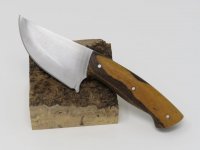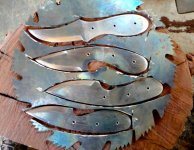Mike Stafford
Member
- Messages
- 2,357
- Location
- Coastal plain of North Carolina
I have been steadily working through my pile of old saw blades making knives. I am selling these at the barber shop where all the barbers are hunters and members of a very large hunting club. This barber shop is frequented by many, many hunters so it has proven to be a great venue for sales of these knives. I have been trying to make knives that would be useful to these hunters for skinning and dressing out their kills of deer, hogs and turkeys.
I built a jig out of two pieces of plywood screwed together at a right angle. On the back leg I installed two t-nuts by counter sinking them into the plywood deep enough that I could use round head bolts. By extending these round head bolts which I lock into place with nuts I can set it for whatever angle I like for grinding the bevel on my knife blanks. These round head bolts slide along on the table of my belt sander and help me to get a somewhat consistent bevel grind. On the vertical leg I drilled a series of countersunk holes into which I can screw dry wall screws. I use these screws to support and locate the blade consistently while grinding. It works pretty well. I got the idea from a picture I saw of a similar jig manufactured from a piece of angle iron. Of course the angle iron had tapped and threaded holes for bolts.
This is one of my newest shapes handled in bocote. It is about 8 inches long. I have not been able to achieve a mirror finish on my blades despite polishing through 1000 grit. I am doing this polishing by hand and it is the most tedious part of the entire process.

I built a jig out of two pieces of plywood screwed together at a right angle. On the back leg I installed two t-nuts by counter sinking them into the plywood deep enough that I could use round head bolts. By extending these round head bolts which I lock into place with nuts I can set it for whatever angle I like for grinding the bevel on my knife blanks. These round head bolts slide along on the table of my belt sander and help me to get a somewhat consistent bevel grind. On the vertical leg I drilled a series of countersunk holes into which I can screw dry wall screws. I use these screws to support and locate the blade consistently while grinding. It works pretty well. I got the idea from a picture I saw of a similar jig manufactured from a piece of angle iron. Of course the angle iron had tapped and threaded holes for bolts.
This is one of my newest shapes handled in bocote. It is about 8 inches long. I have not been able to achieve a mirror finish on my blades despite polishing through 1000 grit. I am doing this polishing by hand and it is the most tedious part of the entire process.



